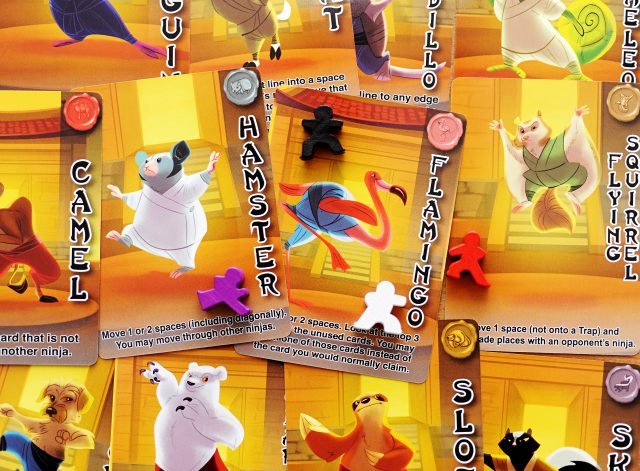When I was a kid we didn’t go to camp. We had a cottage on beautiful Georgian Bay where we’d hunt snakes, swim, fish, and generally enjoy the summer in a non-structured way. Most of what I learned about camp comes from movies like Meatballs and Sleepaway Camp, so Ninja Camp ensured an eye-opening experience.
In Ninja Camp you take on the role of students of Sensei Saru. You join an animal clan and enter the dojo for a full day of exercises. The student who performs the best will take their place by the side of the Sensei as his prize pupil.
The dojo is made up of a grid of cards. Everyone starts with An Evade card and a Sprint card, and they are dealt a random animal clan card that has a powerful one-time use. One at a time players will place their ninja meeples on the grid, until everyone has three ninjas in the dojo. Now you’re ready for some ninja action.
In turn, you’ll play a card from your hand and follow its instructions, moving one of your ninjas in the dojo. So an Evade card allows you to move three spaces, but never cross the same one, or the Sprint allows you to move in a straight line until you hit an edge, wall, or other ninja. Once you’ve executed that action, you can grab the card your ninja was just standing on. This is a card for you to play on future turns, and it also creates a hole in the board that everyone now has to navigate. You have to be able to full execute a card to use it.
 Once per game, you can also use your clan ability. These will give you a tactical advantage if used at the right time. For example the Camel will allow you to move to any card in the dojo, not adjacent to another ninja, or the Penguin lets you take a card from your discard and immediately play it again. Using your clan skill effectively can give you a huge advantage in the game.
Once per game, you can also use your clan ability. These will give you a tactical advantage if used at the right time. For example the Camel will allow you to move to any card in the dojo, not adjacent to another ninja, or the Penguin lets you take a card from your discard and immediately play it again. Using your clan skill effectively can give you a huge advantage in the game.
Also lurking in the dojo are Traps and Walls. A Wall is just essentially a dead space that gets in your way. You can’t move through it or claim it (it’s a wall dummy). Traps are interesting. You may be forced to move on to one to claim a card your ninja is on, but once on a Trap you won’t want to move. It’s worth a negative point in end game scoring, but even worse, it can’t be played. That means, you’re down to one option in your hand. Tough to pull off sweet moves when you’re handicapped in that way.
Play will progress in this fashion, with everyone taking turns moving around the dojo and collecting cards. As you use your skills, they get discarded into your own discard pile. Each one (aside from the starters) are worth a certain value. As the board gets smaller and smaller, players will have fewer options. Their ninjas will get stranded and eventually, they’ll have to pass. Once everyone has passed, the game is over.
At the end of the game you’ll total up the value of the cards in your discard and your hand, adding in the value of the cards your ninjas are currently standing on in the dojo. The student that has acquired the most skill points wins the day.
Ninja Camp is a pretty neat idea for a game. It takes the disappearing board idea from Hey, That’s My Fish, but adds a whole new level of strategy. You have to consider where in the dojo is the best for moving again on a future turn, but you’re also tied to the cards in your hand. A Leap card only allows you to move over empty spaces and an Ambush card forces you to move into a space with an opponent and push them back, but if there’s no space for them to move to, you can’t execute that card. Placement becomes extraordinarily important and you’ll find yourself planning several moves in advance.
I have to say, I’m impressed with Ninja Camp. It takes a solid idea for a game and makes it better. You’ll feel the pressure as your options shrink and maximizing your move becomes more and more important. This is a fun tense battle for two to four players and I can highly recommend it. If you like Hey, That’s My Fish, try Ninja Camp and take your skills to the next level.
Comments
No comments yet! Be the first!